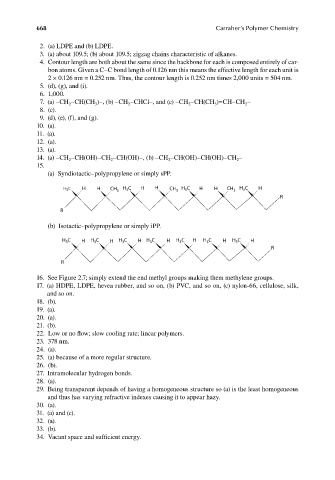Page 705 - Carrahers_Polymer_Chemistry,_Eighth_Edition
P. 705
668 Carraher’s Polymer Chemistry
2. (a) LDPE and (b) LDPE.
3. (a) about 109.5; (b) about 109.5; zigzag chains characteristic of alkanes.
4. Contour length are both about the same since the backbone for each is composed entirely of car-
bon atoms. Given a C–C bond length of 0.126 nm this means the effective length for each unit is
2 × 0.126 nm = 0.252 nm. Thus, the contour length is 0.252 nm times 2,000 units = 504 nm.
5. (d), (g), and (i).
6. 1,000.
7. (a) –CH –CH(CH )–, (b) –CH –CHCl–, and (c) –CH –CH(CH )=CH–CH –
2 3 2 2 3 2
8. (c).
9. (d), (e), (f), and (g).
10. (a).
11. (a).
12. (a).
13. (a).
14. (a) –CH –CH(OH)–CH –CH(OH)–, (b) –CH –CH(OH)–CH(OH)–CH –
2 2 2 2
15.
(a) Syndiotactic–polypropylene or simply sPP.
H 3 C H H CH 3 H C H H CH 3 H C H H H CH 3 H C H
3
3
3
R
R
(b) Isotactic–polypropylene or simply iPP.
H C H H C H H C H H C H H C H H C H H C H
3
3
3
3
3
3
3
R
R
16. See Figure 2.7; simply extend the end methyl groups making them methylene groups.
17. (a) HDPE, LDPE, hevea rubber, and so on, (b) PVC, and so on, (c) nylon-66, cellulose, silk,
and so on.
18. (b).
19. (a).
20. (a).
21. (b).
22. Low or no flow; slow cooling rate; linear polymers.
23. 378 nm.
24. (a).
25. (a) because of a more regular structure.
26. (b).
27. Intramolecular hydrogen bonds.
28. (a).
29. Being transparent depends of having a homogeneous structure so (a) is the least homogeneous
and thus has varying refractive indexes causing it to appear hazy.
30. (a).
31. (a) and (c).
32. (a).
33. (b).
34. Vacant space and suffi cient energy.
9/14/2010 3:44:11 PM
K10478.indb 668
K10478.indb 668 9/14/2010 3:44:11 PM

